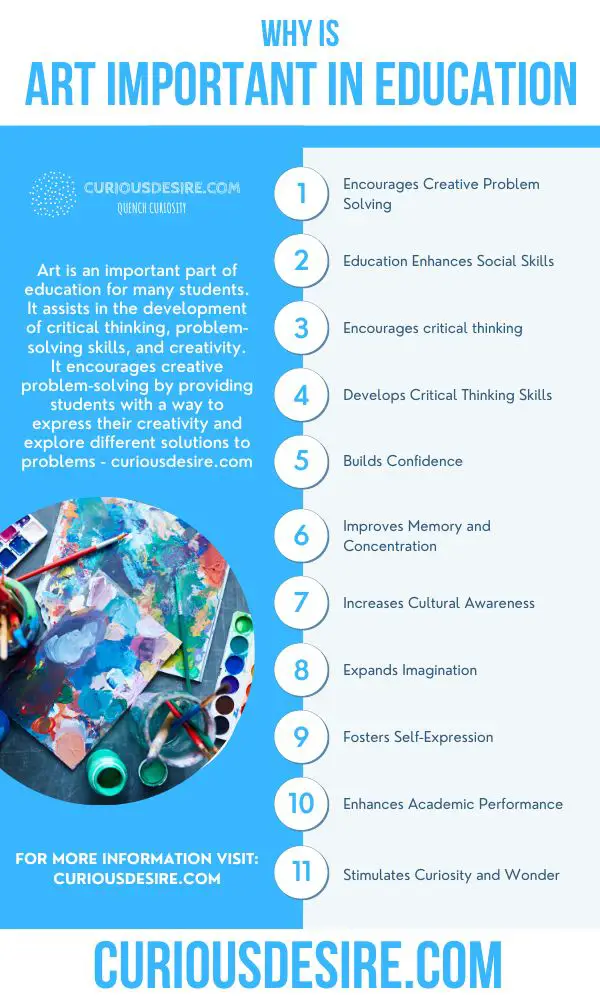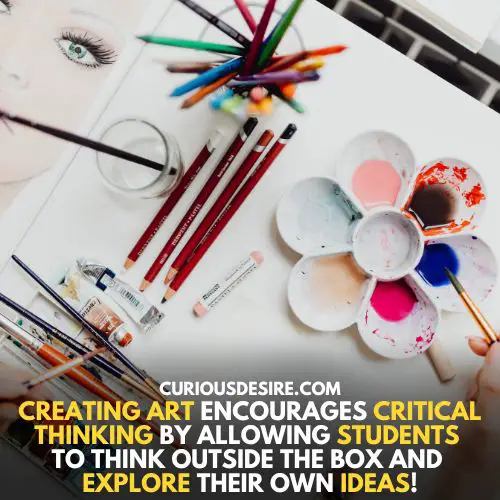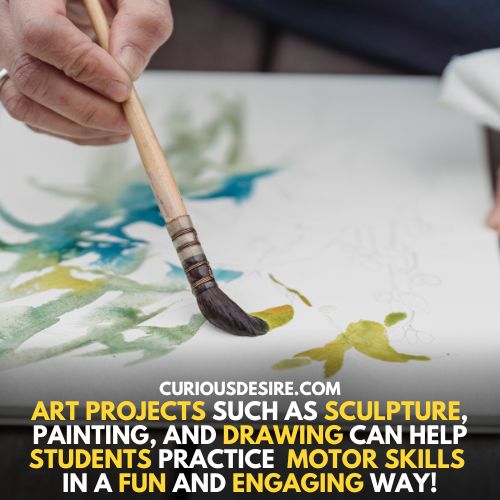Art is an important part of education for many students. It assists in the development of critical thinking, problem-solving skills, and creativity. The importance of art in education helps to improve student engagement and allows them to express themselves in unique ways. It can also promote positive mental health and well-being.
In this article, we take a look at 15 reasons for the importance of art in education.
15 Benefits of Art in Education & How It Helps in Learning
Art plays an important role in education, particularly when it comes to engaging students and enhancing learning. Art helps children express themselves creatively, encourages critical thinking skills, stimulates the imagination, enhances problem-solving abilities, provides opportunities for collaboration and exploration of ideas and cultures, develops hand-eye coordination skills, promotes self-expression, provides a safe space to discuss and work through emotions, and so much more.

Here are some reasons for the importance of art in education:
1. Art Encourages Creative Problem Solving
Art encourages creative problem-solving by providing students with a way to express their creativity and explore different solutions to problems. This can be especially helpful in tackling complicated math and science problems that require creative thinking.
By engaging in the creative process, students can become more comfortable with taking risks and open their minds to potential innovative solutions. Through art, students have the ability to create something that is completely unique and helps them to discover new ways of looking at problems.
2. Art in Education Enhances Social Skills
Creating art provides opportunities for collaboration with other students, which helps improve communication and social skills. Art encourages collaboration between students, which helps to improve their communication and social skills. Through art activities, such as drawing or painting together, students gain the opportunity to bond with fellow peers and learn how to collaborate on projects. This can help them better understand one another and develop strong interpersonal relationships.
Working together in groups can also increase empathy and tolerance for diverse viewpoints. By understanding the creative process and how others express themselves, students can learn to appreciate different forms of art and respect one another’s differences.
3. It Develops Critical Thinking Skills
By creating and analyzing artwork, students are able to practice their critical thinking skills and develop their own opinions on the piece. This encourages them to think more deeply about the underlying meanings of the work, which can be beneficial in developing an appreciation for art as well as learning how to apply it in other areas of life.
Creating art encourages critical thinking by allowing students to think outside the box and explore their own ideas. They are given a chance to express their own thoughts and feelings without being judged.
By engaging in the creative process, students are required to ask questions, observe carefully, analyze information, and develop hypotheses. This helps them become better problem solvers and more effective critical thinkers. Through art analysis, students can become more analytical thinkers, which can help them in school and beyond.

4. Art in Education Builds Confidence
Art can help boost a student’s confidence since they are able to produce something meaningful and tangible. This encourages students to take risks and explore new ideas, which can lead to a greater sense of self-assurance.
The creative process also allows students to gain control over their own learning, which can increase their confidence in their abilities. Moreover, when students participate in art projects and activities, they receive recognition for their efforts, which helps to build a strong sense of self-worth.
Suggested Readings:
5. It Improves Memory and Concentration
Creating art projects requires a lot of focus, enabling students to improve their memory and concentration. Working on art has been proven to help children with ADHD as it teaches them to keep their minds on one task at a time. Art activities encourage learners to pay attention to details and also help them stay focused for longer periods of time.
Art can also help improve memory and recall. By engaging in creative activities, students are able to remember information better and more easily recall what they have learned. This can be extremely helpful when learning new material or studying for exams.
6. Art Increases Cultural Awareness
Art provides students with an opportunity to learn about different cultures and views that they may not have access to in their everyday lives. Through art, students are exposed to a variety of styles, mediums, and concepts that come from different parts of the world. This helps broaden their perspectives and deepen their understanding of how other people live and think.
Moreover, art can also provide students with a means to explore the history of their own culture. By creating art projects related to their own heritage and family history, students can gain an appreciation for where they come from and how it has shaped them.
7. Art in Education Expands Imagination
Art is a great way to encourage imagination and exploration. By engaging in creative activities, students are able to explore their own thoughts and feelings in order to express themselves in unique ways.
This can help them develop problem-solving skills by thinking beyond the normal boundaries of their own knowledge and understanding. Furthermore, it can also challenge their existing beliefs and encourage them to consider alternative perspectives.
8. It Fosters Self-Expression
Art provides a unique way for students to express themselves in a creative way that is not offered in other traditional subjects. Through art, they can explore their own emotions and ideas in a safe environment. This allows them to gain confidence in their own voices and develop their personal identities.
Creating art provides an outlet for students to release stress and channel emotions in a positive way. Art projects also serve as powerful mediums for self-expression, giving students a platform to communicate their feelings and experiences.
9. Enhances Academic Performance
Studies have shown that students who participate in art classes tend to have higher academic performance than those who do not. This is due to a number of reasons, including increased focus, improved memory, and better problem-solving skills.
One of the primary benefits of engaging in art class is that it allows students to hone their focus and pay attention to details. Working on art projects requires a level of concentration that can help students improve their overall academic performance.
10. Stimulates Curiosity and Wonder
Art encourages curiosity and exploration, which provides students with the opportunity to engage in creative activities and pursue knowledge through self-discovery. When students are exposed to art, they develop a natural curiosity to explore their own thoughts and feelings as well as different perspectives from cultures around the world.
Through creativity, students can gain confidence in their own abilities by creating meaningful works of art.
Moreover, art also promotes a sense of wonder and appreciation for the beauty in life. By engaging in creative activities, students can gain an understanding of how to look at the world from different angles and recognize the importance of celebrating creativity and diversity.
11. Improves Motor Skills
Participating in art projects is an excellent way to help develop fine motor skills, which can be beneficial for a variety of tasks, such as handwriting and using a computer. Fine motor skills are movement activities that involve the coordination of small muscles in the hands and fingers with the eyes. These skills will enable a person to use tools, manipulate objects, and perform other activities with precision.
Art projects such as sculpture, painting, and drawing can help students practice these skills in a fun and engaging way. The practice of art is also beneficial for developing gross motor skills, which involve the larger muscle groups that are used in activities like running, jumping, and climbing.

12. Builds Understanding of the Arts
Learning about different kinds of art can help you understand the stories and traditions behind them. Art classes can provide students with the opportunity to gain an appreciation for different art forms from around the world and be exposed to different cultural perspectives.
Studying art history can also give students a better understanding of how certain movements have influenced culture, as well as what kind of impact it has had on society. Being knowledgeable about art can help you better appreciate its beauty and value.
13. Encourages Interdisciplinary Learning
In addition to teaching students the fundamentals of art, art classes can also encourage interdisciplinary learning by presenting material in different ways.
For example, an art class could explore the relationship between music, literature, history, and other academic subjects. This type of learning encourages students to think differently and develop connections between different disciplines.
Furthermore, art classes can also give students an opportunity to explore various career paths related to the creative arts, such as graphic design, photography, animation, or fashion. This could be a great way for students who are struggling in other academic areas to find something they’re passionate about.
Suggested Readings
14. Develops Skills That Translate into Other Areas
The skills developed through art classes, such as problem-solving and creative thinking, are applicable to other areas of life. Art is a great way to improve executive functioning skills by teaching students how to plan, organize, and prioritize projects. The ability to think critically and analyze information can be beneficial in many aspects of life, such as understanding difficult texts or developing a solution to a problem.
In addition, art can help cultivate communication and collaboration skills through group projects and tasks that require students to work together. These types of skills are essential in our increasingly globalized world, where teamwork is becoming more commonplace.
15. Increases Appreciation for Different Perspectives
By participating in art projects, individuals can gain a greater understanding of different perspectives and be more tolerant of different ideas. Art forms such as painting, sculpture, and drawing require the individual to use their imagination, which can open up their mind to new ways of looking at the world.
Through exploring these creative activities, they can develop an understanding of different cultures and life experiences.
Overall, art classes can provide individuals with a variety of benefits that go far beyond the confines of the classroom. From developing fine motor skills to an increasing appreciation for different perspectives, there are many advantages to taking art classes. So don’t be afraid to explore your creative side. Art classes can be an incredibly rewarding and enriching experience.
Conclusion
The importance of art in education is undeniable and should be incorporated into every student’s learning experience. Art encourages creative problem-solving, builds confidence, and enhances social skills. It also promotes self-expression, stimulates curiosity and wonder, and helps with critical thinking.
Ultimately, art provides students with the opportunity to explore their creativity, learn new skills, and gain an appreciation for different perspectives. In doing so, they will be prepared to tackle the challenges of their academic and professional lives.